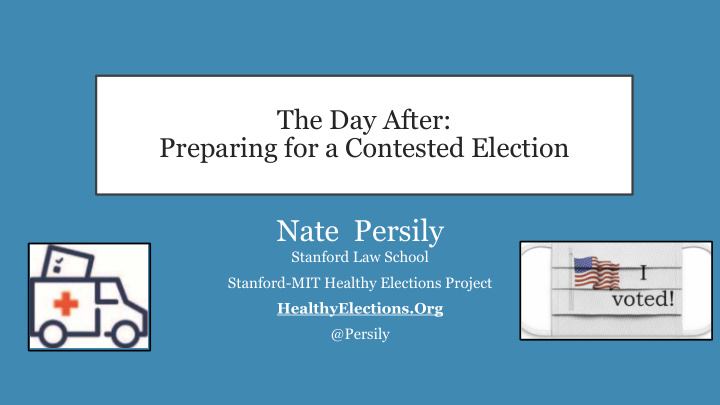



The Day After: Preparing for a Contested Election Nate Persily Stanford Law School Stanford-MIT Healthy Elections Project HealthyElections.Org @Persily
Litigation Contingencies in the 2020 Election • Who is perceived as “in the lead” at each stage? • The Nature of the Dispute • Traditional – Absentee Ballots, Provisional Ballots, Recounts • Non-Traditional – Polling Place Violence, Unprecedented Use of Federal Authority, Post Office • Forum • Local, State or Federal • Which state? And who controls it? • Courts, Administrative Process, Legislature • Actors • State – Legislature, Governor, Courts • Federal – Courts, Congress, Executive (Vice-President) • Applicable Law (and how well decided) • State election laws • Electoral Count Act • U.S. Constitution
Key Phases in Resolution of 2020 Election Disputes 3 November: Election Night 3-20November: Deadlinesforreceiptofballots;expirationof “cure” periodfordefectiveballots 17 November-3* December: Deadlines for canvassing and certification 8 December: Safe HarborDeadline of Electoral CountAct 14 December: Meeting of Electoral College 6 January: Counting of electoral votes;first session of 117th Congress 20 January: Inaugurationday;expiration of President’s term
How to think about the election litigation calendar: Pre-Election Day Litigation • Pre-October (over 200 cases already filed) • Work the refs • Establish the ground rules • October • Protect and promote early/absentee voting • Address extraordinary COVID-related actions by Governors, Secretaries of State and Election officials • Trial runs for absentee ballot and voter disqualification (signature matching, curing etc.) • Litigation over administrative failures (voter registration and mail ballot distribution system) • Week before election • Litigation over rules for election day voting (polling place changes, material shortages, etc.) • Expanding deadlines for early and absentee voting. • Injunctions to deal preemptively with vote suppression.
How to think about the election litigation calendar: Election Day and the Day After • Election Day • Polling place violence/malfeasance • Polling place dysfunction (lines, machine breakdowns, material/personnel shortages) • Extension of time for voting or receipt of mail ballots • Possible battles between state and federal authority over polling places • Immediate Aftermath • Depends on (1) who is ahead, by how much, and where; (2) nature of disputes arising in early voting and election day; (3) number of uncounted ballots. • Locally controlled administrative process involved in counting ballots. • (Mostly) state court litigation over counting of legal votes and disqualification of illegal votes. • Absentee ballots (lateness, signatures, fraud…) – see https://tinyurl.com/mailballotcases • Provisional ballots (unregistered voters, wrong ballots, illegal voters) • Disputed polling place ballots (overvotes/undervotes)
How to think about the election litigation calendar: The week (or two) after Election Day • Continue processing and counting mail ballots (some states allow ballots to be received up to two weeks after Election Day) • Rush to cure defective mail ballots • Litigation over rules applied in canvassing process (e.g., whether courts are applying law as intended by legislature)
How to think about the election litigation calendar: The month after Election Day (until Dec 8) • **Dec 8 = Safe Harbor Deadline of Electoral Count Act (rush to finish count and have it certified or for state legislature to appoint electors) • **Dec 14 = Meeting of Electoral College • 2000 (Bush v. Gore) path • Action in both state and federal court over legality of count. • Supreme Court effectively declares which count is valid • 1876 path • Competing slates of electors from state legislatures, governors, and courts.
How to think about the election litigation calendar: December 14-January 20 • **January 6 = Counting of electoral votes • **January 20 = Inauguration Day • Open questions • Which slates of electors are considered legitimate according to the safe harbor of the Electoral Count Act? • Who decides among competing slates of electors? Vice-President? • Can the House shut down proceedings and thereby trigger the 20 th Amendment (leading to Nancy Pelosi being President)?
HealthyElections.Org
SOURCES OF LAW RELATED TO MAIL- BALLOT LITIGATION • First and Fourteenth Amendments • Fourteenth Amendment Weighs burden on right to vote Balances interest of the individual in • • Fundamental Procedural Due against state’s asserted interests process with interests of the state Right to Vote Process • Section 2 (racial vote dilution) Fourteenth Amendment • • Section 3(b) and 201 (ban on “tests • Protects against disparate treatment Voting Rights Equal or devices”) of similarly situated voters Act Protection • Section 208 (assistance for disabled voters) • State constitutions • Title II (prohibits discrimination Americans with State Law State law • against disabled individuals) Disabilities Act Claims
Recommend
More recommend